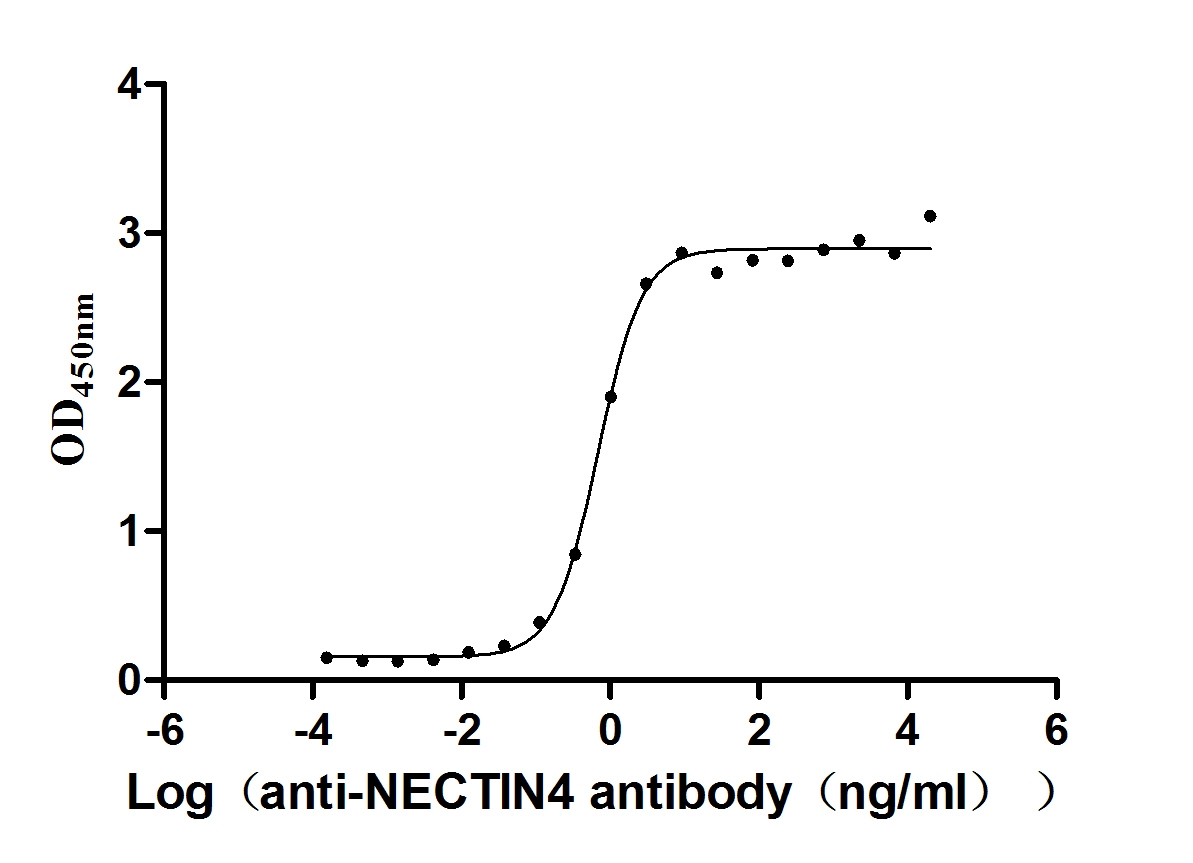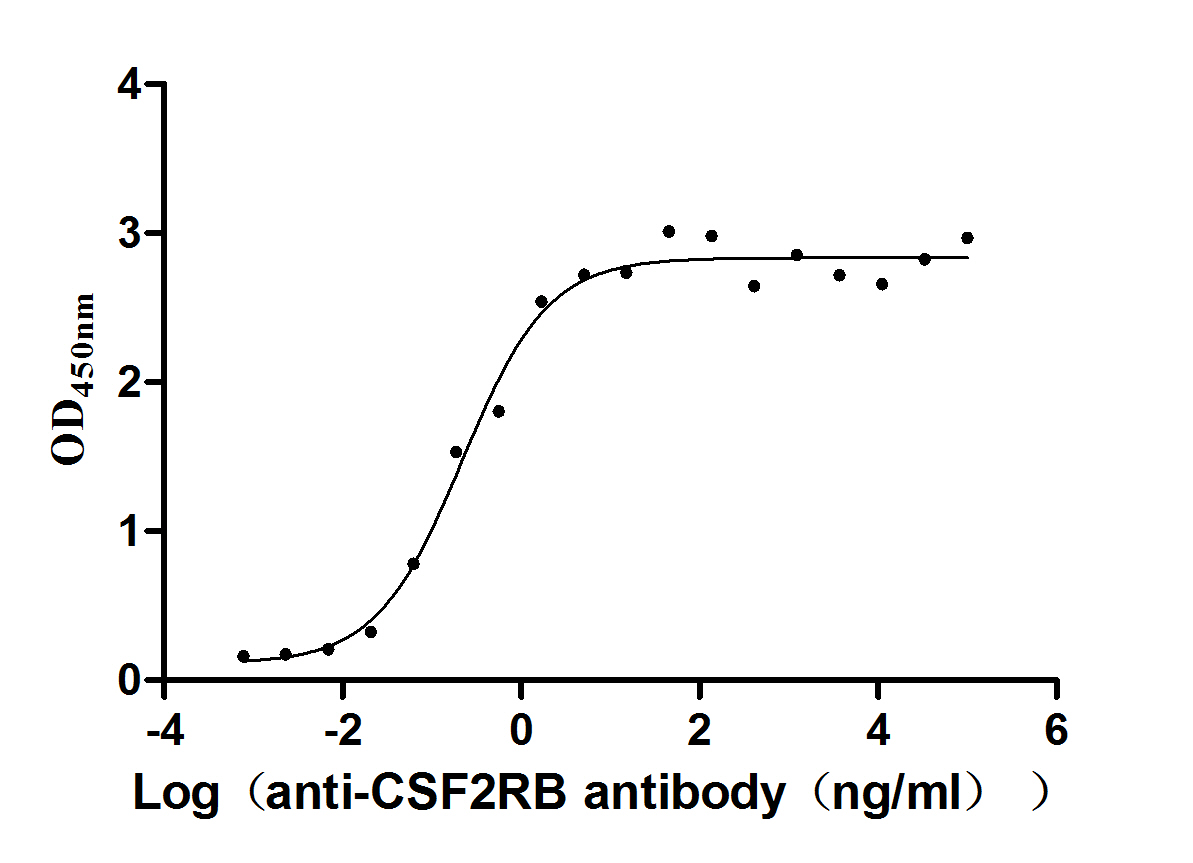Recombinant Mouse Somatostatin (Sst), partial
In Stock-
中文名稱:小鼠Sst重組蛋白
-
貨號:CSB-EP022723MO
-
規(guī)格:¥1836
-
圖片:
-
其他:
產(chǎn)品詳情
-
純度:Greater than 85% as determined by SDS-PAGE.
-
基因名:Sst
-
Uniprot No.:
-
別名:(NST)
-
種屬:Mus musculus (Mouse)
-
蛋白長度:Partial
-
來源:E.coli
-
分子量:18.5 kDa
-
表達(dá)區(qū)域:89-116aa
-
氨基酸序列SANSNPAMAPRERKAGCKNFFWKTFTSC
Note: The complete sequence including tag sequence, target protein sequence and linker sequence could be provided upon request. -
蛋白標(biāo)簽:N-terminal 6xHis-KSI-tagged
-
產(chǎn)品提供形式:Liquid or Lyophilized powder
Note: We will preferentially ship the format that we have in stock, however, if you have any special requirement for the format, please remark your requirement when placing the order, we will prepare according to your demand. -
緩沖液:If the delivery form is liquid, the default storage buffer is Tris/PBS-based buffer, 5%-50% glycerol. If the delivery form is lyophilized powder, the buffer before lyophilization is Tris/PBS-based buffer, 6% Trehalose.
-
復(fù)溶:We recommend that this vial be briefly centrifuged prior to opening to bring the contents to the bottom. Please reconstitute protein in deionized sterile water to a concentration of 0.1-1.0 mg/mL.We recommend to add 5-50% of glycerol (final concentration) and aliquot for long-term storage at -20℃/-80℃. Our default final concentration of glycerol is 50%. Customers could use it as reference.
-
儲存條件:Store at -20°C/-80°C upon receipt, aliquoting is necessary for mutiple use. Avoid repeated freeze-thaw cycles.
-
保質(zhì)期:The shelf life is related to many factors, storage state, buffer ingredients, storage temperature and the stability of the protein itself.
Generally, the shelf life of liquid form is 6 months at -20°C/-80°C. The shelf life of lyophilized form is 12 months at -20°C/-80°C. -
貨期:3-7 business days
-
注意事項(xiàng):Repeated freezing and thawing is not recommended. Store working aliquots at 4°C for up to one week.
-
Datasheet & COA:Please contact us to get it.
相關(guān)產(chǎn)品
靶點(diǎn)詳情
-
功能:Inhibits the secretion of pituitary hormones, including that of growth hormone/somatotropin (GH1), PRL, ACTH, luteinizing hormone (LH) and TSH. Also impairs ghrelin- and GnRH-stimulated secretion of GH1 and LH; the inhibition of ghrelin-stimulated secretion of GH1 can be further increased by neuronostatin.; May enhance low-glucose-induced glucagon release by pancreatic alpha cells. This effect may be mediated by binding to GPR107 and PKA activation. May regulate cardiac contractile function. May compromise cardiomyocyte viability. In the central nervous system, may impair memory retention and may affect hippocampal excitability. May also have anxiolytic and anorexigenic effects. May play a role in arterial pressure regulation. May inhibit basal, but not ghrelin- or GnRH-stimulated secretion of GH1 or LH, but does not affect the release of other pituitary hormones, including PRL, ACTH, FSH or TSH. Potentiates inhibitory action of somatostatin on ghrelin-stimulated secretion of GH1, but not that on GnRH-stimulated secretion of LH.
-
基因功能參考文獻(xiàn):
- We show that removal of the paracrine influence of SST suppresses the ability of KATP channel blockers or KATP channel ablation to inhibit glucagon release PMID: 30115649
- Synapses from somatostatin-expressing interneurons are regulated by NMDA receptors, signaling through R-type calcium channels. PMID: 29295931
- The findings reveal a proaddiction adaptive response to chronic nicotine in which nitric oxide and SST are released by a specific CHRNA5-expressing neuronal population to provide retrograde inhibition of the habenula- interpeduncular nucleus circuit and thereby enhance the motivational properties of nicotine. PMID: 29158387
- Obesity- and gender-dependent role of endogenous somatostatin and cortistatin in the regulation of endocrine and metabolic homeostasis in mice. PMID: 27901064
- HIV-1 Tat causes cognitive deficits and selective loss of parvalbumin, somatostatin, and neuronal nitric oxide synthase expressing hippocampal CA1 interneuron subpopulations. PMID: 27178324
- Suppressing somatostatin (SOM) neurons enhanced the Excitation and Inhibition underlying size tuning, explaining SOM neurons' role in surround suppression. PMID: 28858618
- dendrite-targeting somatostatin interneurons are critical for a visually induced, context-dependent gamma rhythm in visual cortex. PMID: 28481348
- The results of this study provided the first in vivo evidence that SOM(+) neurons represent a Central Amygdala population that acquires learning-dependent sensory responsiveness during fear conditioning and furthermore reveal an important role of these neurons in gating passive versus active defensive behaviors. PMID: 27307236
- preinspiratory Dbx1 neurons are rhythmogenic, inspiratory Dbx1+ and SST+ neurons primarily act to pattern respiratory motor output, and SST+-neuron-mediated pathways and postsynaptic inhibition modulate breathing pattern. I PMID: 27497222
- Endogenous SST and CORT distinctly impact on DMBA-induced mammary gland tumorigenesis , in a manner that is strongly dependent on the metabolic/endocrine milieu (lean vs. obese status). PMID: 26956474
- This study demonstrated that Hippocampal Somatostatin Interneurons Control the Size of Neuronal Memory Ensembles. PMID: 26875623
- Neuronostatin acts via GPR107 to increase cAMP-independent PKA phosphorylation and proglucagon mRNA accumulation in pancreatic alpha-cells. PMID: 26561648
- Data indicate that somatostatin (SST)-secretion is regulated by incretin hormones, cholecystokinin, acetylcholine, vasoactive intestinal polypeptide, calcitonin gene-related polypeptide, oligopetides, and trace amines. PMID: 26241122
- Data indicate all gastric mucosa receptors through which somatostatin (SST) secretion is regulated by hormones, neurotransmitters, neuropeptides and metabolites that act directly on the SST cells. PMID: 26181106
- The data of this study suggested that (1) low SST has a causal role in mood-related phenotypes, (2) deregulated EIF2-mediated protein translation PMID: 25600109
- The PTEN autism spectrum disorder alleles are hypomorphic in regulating cell size and the parvalbumin/somatostatin ratio in comparison to WT PTEN. PMID: 25937288
- Nearly all parvalbumin interneurons express Lynx1 did not detect Lypd6 in this population. Conversely, in somatostatin interneurons Lypd6 was found in a subset localized to deep cortical layers but no somatostatin neurons show detectable levels of Lynx1. PMID: 25359633
- The paracrine actions of Ucn3 activate a negative feedback loop that promotes somatostatin release to ensure the timely reduction of insulin secretion upon normalization of plasma glucose. PMID: 26076035
- Levels of TGF-beta1, a factor implicated in tissue remodelling, together with SMAD phosphorylation through which TGF-beta mediates its effects, were increased in the somatostatin knockout pancreas. PMID: 25350519
- SOM regulates both parasite burden and granulomatous inflammation perhaps through modulating granuloma production of IFN-gamma and IL-1b PMID: 25530957
- The role of somatostatin in the expression of growth hormone in male and female mice is reported. PMID: 25551181
- Somatostatin and insulin together are critical paaracrine mediators of glucose-inhibited glucagon secretion and function by lowering cAMP/PKA signaling with increasing glucose. PMID: 25406263
- Somatostatin-containing interneurons are involved in learning-induced changes in the inhibitory cortical network. PMID: 24055404
- Impaired excitability of somatostatin- and parvalbumin-expressing cortical interneurons in a mouse model of Dravet syndrome. PMID: 25024183
- SST, in a circadian manner and putatively via its regulation of expression in the amygdala, modulates behavior responding to mildly aversive conditions in mice. PMID: 24376834
- Somatostatin-positive interneuron populations are altered by thyroid hormone deficiency. PMID: 24333174
- when activated by SST-14, SSTR2A internalizes and recycles via the Golgi, which requires ECE-1 degradation of SST-14 and receptor dissociation from beta-arrestins PMID: 23913690
- Findings suggest that somatostatin and its receptors (SSTR2 and SSTR5) are important markers in the regulation and development of Sertoli cell. PMID: 23831358
- The results further support a role for endogenous SST in regulating l-Arg-mediated insulin release. PMID: 23696563
- SST-like immunoreactivity, while comparable in most regions of hypothalamus, diminished significantly in arcuate nucleus of ApoD(-/-) mice. PMID: 22581439
- Expression of somatostatin mRNA was increased in the hypothalamus in anorectic mice fed a Val-deficient diet. PMID: 21293891
- Nkx2.2-/-Arx- ghrelin+ cells also express the somatostatin hormone PMID: 21880149
- the role of endogenous CST is different from SST; CST exerted an unexpected stimulatory role on prolactin secretion PMID: 21971153
- Data show that gastric infection and inflammation is associated with increased IFNgamma expression and reduced ghrelin expression, and that IFNgamma does not directly control ghrelin expression but inhibits it indirectly via somatostatin. PMID: 21912454
- Data from studies on islets of Sst knockout mice suggest that paracrine interactions between delta- and alpha-cells provide intra-islet Sst-mediated paracrine communication that facilitates release of glucagon in response to sympathetic activation. PMID: 21099335
- investigation of role of somatostatin and somatostatin receptors in sexually dimorphic pattern of growth hormone expression in fasting/fed states; studies in hypothalamus, pituitary, and stomach; studies with male and female SST-knockout mice PMID: 20943754
- Somatostatin secretion is greatly facilitated by cell-to-cell interactions and E-cadherin expression. PMID: 20637727
- Data show that approximately 95% of mouse olfactory bulb somatostatin-immunoreactive cells describe a homogeneous population of interneurons. PMID: 20394054
- Extraovarian somatostatin, acting through its receptors 2 and 5 present on granulosa cells, may be involved in mouse folliculogenesis by reducing recruitment of resting follicles. PMID: 20056831
- opposite and stage-specific effects on the migration of cerebellar granule cells PMID: 11780120
- Somatostatin acts as a selective chemoattractant for immature hematopoietic cells PMID: 11823046
- substance P and somatostatin are temporally expressed in granulomas associated with murine cysticercosis, which may be related to differential expression of Th1 and Th2 cytokines PMID: 12117965
- Brain somatostatin receptors 1,2,4 and 5 are up-regulated in somatostatin-deficient mice, and SSTR3 is down-regulated. PMID: 12145348
- adrenomedullin, acting via intramural fundic neurons, stimulates somatostatin and thus inhibits histamine and acid secretion PMID: 12573799
- Somatostatin regulates ductal bile formation in mice by inhibition of ductal fluid secretion, also by stimulation of ductal fluid absorption via interacting with SSTR2 on cholangiocytes, a process involving the intracellular cAMP/cGMP second messengers. PMID: 12676656
- In whole area of hippocampus, NPY-, SOM- (somatostatin), CCK-, and VIP-positive neurons accounted for about 31%, 17%, 7%, and 8% of GABAergic neurons, respectively. PMID: 12746872
- Infrequent colocalization of nNOS and somatostatin in mouse hippocampus. Double-labeled cells may be particular subpopulation of hippocampal GABAergic nonprincipal neurons. PMID: 15026120
- In embryonic kidneys, SRIF is expressed first at the interface of the metanephric mesenchyme and basolateral ureteric bud and later in maturing thin descending limbs of Henle. Expression in the thin descending limb persists in the adult kidney. PMID: 15496149
- In the hippocampus of a transgenic Alzheimer's disease model at 6 months of age, the expression of somatostatin (SOM) and NPY neuropeptides displayed a significant decrease PMID: 16271420
- Somatostatin inhibits oxidative respiration in pancreatic beta-cells PMID: 16357046
顯示更多
收起更多
-
亞細(xì)胞定位:Secreted.
-
蛋白家族:Somatostatin family
-
組織特異性:In the pancreas, somatostatin is expressed in delta cells of the islets of Langerhans. In the stomach, it is expressed in parietal cells of oxyntic mucosa and in the small intestine, it is found in the villus (at protein level). Neuronostatin is expressed
-
數(shù)據(jù)庫鏈接:
Most popular with customers
-
Recombinant Human Retinol-binding protein 4 (RBP4) (Active)
Express system: Mammalian cell
Species: Homo sapiens (Human)
-
Recombinant Mouse GDNF family receptor alpha-like (Gfral), partial (Active)
Express system: Mammalian cell
Species: Mus musculus (Mouse)
-
Recombinant Human Nectin-4 (NECTIN4), partial (Active)
Express system: Mammalian cell
Species: Homo sapiens (Human)
-
Recombinant Human Cytokine receptor common subunit beta (CSF2RB), partial (Active)
Express system: Mammalian cell
Species: Homo sapiens (Human)
-
Recombinant Human CD81 antigen (CD81), partial (Active)
Express system: Mammalian cell
Species: Homo sapiens (Human)


















